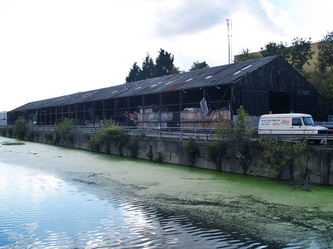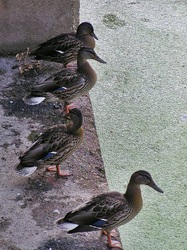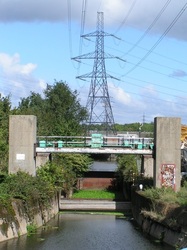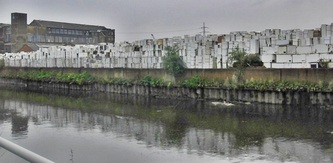London's Lesser Known Rivers - The Bow Backs Rivers - pre Olympics
There are many recent post-Olympics pictures of these rivers knocking around on the internet, but these are some that I took with a tiny pocket camera in 2003. Previously, I first wandered around this network of rivers without a map and got totally lost going around in circles somewhere between Bromley by Bow and Stratford. I didn't pass a soul on foot for hours. Things have changed pretty much beyond recognition with the Olympics being held on this site in 2012 and construction of the stadium. There will always be a bit of me that misses the solitude of this area.....
The Bow Back Rivers are the waterways which feed into the River Lee Navigation and the Thames in East London. They cover an area the equivalent size of the City of London in the triangle between Stratford, Bromley-By-Bow and Hackney Wick and include: City Mill River, Old River Lea, Prescott Channel, Bow Creek, Abbey Creek, Pudding Mill River and Waterworks River.
The Bow Back Rivers are the waterways which feed into the River Lee Navigation and the Thames in East London. They cover an area the equivalent size of the City of London in the triangle between Stratford, Bromley-By-Bow and Hackney Wick and include: City Mill River, Old River Lea, Prescott Channel, Bow Creek, Abbey Creek, Pudding Mill River and Waterworks River.
Evan writes to this website:
"As a young boy I explored many of the places depicted here with great relish, especially the pre-Olympics Bow Backs stretch. I've revisited a handful of times since and felt the same sentiments you have yourself written on the accompanying page. The odd scratch of nostalgia leads me through image searches from time to time, but none so fruitful as this one. Thanks for documenting what I thought I'd only be able to revisit in memory, these locations made a real impact on me"
"As a young boy I explored many of the places depicted here with great relish, especially the pre-Olympics Bow Backs stretch. I've revisited a handful of times since and felt the same sentiments you have yourself written on the accompanying page. The odd scratch of nostalgia leads me through image searches from time to time, but none so fruitful as this one. Thanks for documenting what I thought I'd only be able to revisit in memory, these locations made a real impact on me"
The following is an edit of an article from www.nolondon2012.org about the Bow Backs Rivers:
The waterways flow through an area typified by dereliction, mainly old factories and vacant land. The neglect of the area has, however, been extremely beneficial in terms of wildlife. Natural colonisation by a large variety of native and exotic species supplemented, in places, by tree and shrub planting (the bulk being the work of volunteers), has provided the area with a green 'backdrop' where, in places, it is hard to believe you are in London. The limited amount of vegetation management has resulted in the habitats having a 'wild' feel, as opposed to the frequently cut towpaths of the nearby canal system, where few species get a chance to flower.
Disuse and neglect has also benefited wildlife, and species that are frequently seen in the area are kingfisher, heron, coot, moorhen, mallard, mute swan, green woodpecker, grey wagtail, great-crested and little grebes, dunnock, tits and kestrel, as well as the summer visiting sand martins. Small mammals are frequent in the rough grasslands, as evidenced by hovering kestrels, and there is a rich invertebrate population, which includes a number of notable and rare species. The Olympic proposals will destroy all the existing habitat and thus the associated wildlife. Proposals to provide mitigation in terms of translocating species and providing alternative habitat are unlikely to be successful, and it is only legally protected species that will be the focus of such work. A new 'park' is promised post Olympics, providing a greater amount of open space than now exists. This park will not be created until 2020 (8 years after the games), and meanwhile public amenity of the area will be lost. There are, as yet, no financial arrangements for the management of a new park, and no organisation has claimed they want to run it. By 2020, will anyone remember a park was promised? Claims that these will be a 'green' Olympics are related to recycling, energy generation and use, i.e. green technology, in terms of the environment, they are anything but green. For an area typified as brownfield, apart from the waterways, there are over 500 mature trees in the area - all are to be felled.The river system of the Lower Lea is, according to the Environment Agency, extremely complex and is very important in terms of its flood relief function. The network of channels and their associated wildlife is probably unique in London.
Over the years, the Lower Lea Project/Lea Rivers Trust, have carried out improvements along the waterways, which has involved planting, vegetation management and habitat creation, as well as clean-ups. It has also run an education programme and organised walks which has introduced thousands of children and adults to the waterways.The Olympics will involve the complete re-landscaping of the area, and include lowering towpaths and the creation of land bridges, all intended to get people onto the site quickly. The effect of the number and size of bridges will be to virtually culvert the waterways. The shading effect of bridges means that nothing grows below them, either on land or in the water. The network of waterways will effectively be fragmented and their 'habit corridor' (i.e. continuity) function lost. Proposals to landscaping the bridges is, not only problematic, but does not replace the river environment. Apart from their effect on habitat and wildlife, the bridges will destroy the attractiveness of the towpaths for walking or cycling. Post Olympics, many of the bridges will remain as 'legacy.
The waterways flow through an area typified by dereliction, mainly old factories and vacant land. The neglect of the area has, however, been extremely beneficial in terms of wildlife. Natural colonisation by a large variety of native and exotic species supplemented, in places, by tree and shrub planting (the bulk being the work of volunteers), has provided the area with a green 'backdrop' where, in places, it is hard to believe you are in London. The limited amount of vegetation management has resulted in the habitats having a 'wild' feel, as opposed to the frequently cut towpaths of the nearby canal system, where few species get a chance to flower.
Disuse and neglect has also benefited wildlife, and species that are frequently seen in the area are kingfisher, heron, coot, moorhen, mallard, mute swan, green woodpecker, grey wagtail, great-crested and little grebes, dunnock, tits and kestrel, as well as the summer visiting sand martins. Small mammals are frequent in the rough grasslands, as evidenced by hovering kestrels, and there is a rich invertebrate population, which includes a number of notable and rare species. The Olympic proposals will destroy all the existing habitat and thus the associated wildlife. Proposals to provide mitigation in terms of translocating species and providing alternative habitat are unlikely to be successful, and it is only legally protected species that will be the focus of such work. A new 'park' is promised post Olympics, providing a greater amount of open space than now exists. This park will not be created until 2020 (8 years after the games), and meanwhile public amenity of the area will be lost. There are, as yet, no financial arrangements for the management of a new park, and no organisation has claimed they want to run it. By 2020, will anyone remember a park was promised? Claims that these will be a 'green' Olympics are related to recycling, energy generation and use, i.e. green technology, in terms of the environment, they are anything but green. For an area typified as brownfield, apart from the waterways, there are over 500 mature trees in the area - all are to be felled.The river system of the Lower Lea is, according to the Environment Agency, extremely complex and is very important in terms of its flood relief function. The network of channels and their associated wildlife is probably unique in London.
Over the years, the Lower Lea Project/Lea Rivers Trust, have carried out improvements along the waterways, which has involved planting, vegetation management and habitat creation, as well as clean-ups. It has also run an education programme and organised walks which has introduced thousands of children and adults to the waterways.The Olympics will involve the complete re-landscaping of the area, and include lowering towpaths and the creation of land bridges, all intended to get people onto the site quickly. The effect of the number and size of bridges will be to virtually culvert the waterways. The shading effect of bridges means that nothing grows below them, either on land or in the water. The network of waterways will effectively be fragmented and their 'habit corridor' (i.e. continuity) function lost. Proposals to landscaping the bridges is, not only problematic, but does not replace the river environment. Apart from their effect on habitat and wildlife, the bridges will destroy the attractiveness of the towpaths for walking or cycling. Post Olympics, many of the bridges will remain as 'legacy.









































